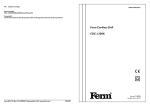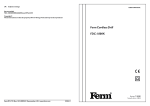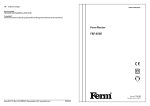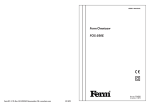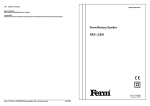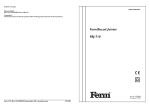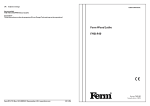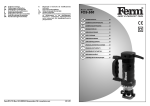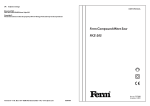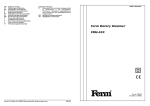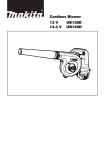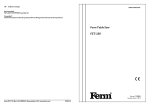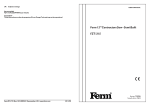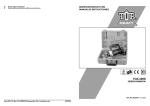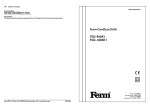Download Ferm Cordless Omnisaw FCO-18K
Transcript
UK Subject to change USER’S MANUAL Document Ref: FCO-18K/52171/AAA00/issue 0/Month 00 Copyright © These instructions are the sole property of Ferm-Omega Tools and may not be reproduced Ferm Cordless Omnisaw FCO-18K NiCd Art.nr. 718210 Screwfix Art.nr. 52171 Ferm BV • P.O. Box 134 • 8280 AC Genemuiden • NL • www.ferm.com 0304-08 EXPLODED VIEW Fig.G Fig. H Fig.A Fig.I Fig.J Fig.K Fig.L Fig.M Fig.N Fig.O Fig.P Fig.B Fig.C Fig.E 2 Fig.D Fig.F Ferm Ferm 11 SPARE PARTS LIST FCO-18K REF NR 001 004 006 T/M 008 009 010 011 013 014 015 016 017 022 022 023 024 025 027 029 _ _ _ 10 DESCRIPTION HOUSING (LEFT) HANDLE SPINDLE LOCK COMPLETE COMPRESSING BOLT BALL BEARING 6002 ZZ ALUMINIUM ENCLOSURE MOTOR ENCLOSURE POLE PLATE BATTERY HOUSING (RIGHT) SPRING COLLET 1/4" SPRING COLLET 1/8" NUT GUARD SUPPORT GUARD KNOB SWITCH CHARGER DUST COLLECTOR WRENCH FOR SPINDLE NUT FERM NR 408717 408715 408718 408719 806002 408720 408721 408722 408723 318211 408724 408725 408726 408727 408728 408701 408702 408729 406655 408698 408699 Fig.Q Fig.R Fig.S Ferm Ferm 3 SAFETY INSTRUCTIONS The following symbols are used in these instructions for use: OMNISAW THE NUMBERS IN THE FOLLOWING TEXT CORRESPOND WITH THE PICTURES AT PAGE 2 Denotes risk of personal injury, loss of life or damage to the tool in case of non-observance of the instructions in this manual. Denotes risk of electric shock. TECHNICAL SPECIFICATIONS Voltage Charger voltage Charger frequency No load speed Battery output Charging time Weight (incl. battery) Lpa (sound pressure) Lwa (sound power) Vibration | | | | | | | | | | — 18 V--230 V 50 Hz 23000/min 1.3 Ah 1 hour 1.8 kg 70.30 dB(A) 81.30 dB(A) 0.63 m/s2 DESCRIPTION Fig.A 1. Base plate and depth guide 2. Collet nut 3. Spindle lock button 4. Exhaust air vents 5. Removable auxiliary handle 6. On/off slide switch 7. Intake air vents 8. Battery 9. Depth guide bracket 10. Depth guide locking knob 11. Locking knob of depth guide bracket 12. Bit 13. Protection guide cap (not shown) PACKAGE CONTENTS 1 Cordless Omnisaw 1 Battery 18 V - FCO-18B 1 Battery charger -FCO-18L 1 1/4" collet 1 1/8" collet 1 Wrench 1 Protection guide cap 1 Dust extraction adapter 1 Carrying case 1 Users manual 1 Warranty card 1 Warranty certificate Check the machine, loose parts and accessories for transport damage. Read through these operating instructions carefully before using the appliance. Become familiar with the functions and method of operation. To ensure proper operation, always maintain the appliance according to the instructions. The operating instructions and associated documents should always be kept close to the appliance. Ferm products are manufactured to high quality standards they are safe and fit for purpose at time of sale, but all tools can be dangerous if the correct precautions are not taken. Always follow these instructions, do not carry out the operation until you are sure you can do so in safety. Remember to consider the work environment for safe operation as well as safety for tool use. A damaged part or guard should be properly repaired by an authorised service centre, unless indicated otherwise in the instruction manual. Have defective switches replaced by an authorised service centre. Do not use a tool if the switch does not turn on and off. Have your tool repaired by an expert This appliance is manufactured in accordance with relevant safety standards. Only experts must carry out repairing of electrical appliances, otherwise considerable danger for the user may result. Storing tools When not in use tools should be stored in the dry, out of reach of children. ELECTRICAL INFORMATION This product is complete with a pre-wired mains plug, it is double insulated in accordance with EN 60335 – no earth wire is required If the plug needs replacing follow these instructions. Wire correctly The wires in the mains lead are coloured in the following way: BLUE • Neutral BROWN • Live Green & Yellow (Earth) Warning! When using electric tools, basic safety precautions should always be followed to reduce the risk of fire, electric shock and personal injury. Read all these instructions before attempting to operate this product. Save these instructions for future reference. PERSONAL SAFETY Use Personal Protection Safety Equipment Protect eyes with safety glasses or goggles note: the use of safety protective eyewear without the CE mark can lead to serious injury if the lens breaks. A suitable dust mask should be worn if cutting; drilling or sanding is dusty, in particular chipboard or MDF. Approved safety footwear and headgear should worn as appropriate, for example on building works or when heavy weights are involved. Wear a suitable apron to protect against sparks/debris. Wear earplugs or ear defenders. Dress properly Do not wear loose clothing or jewellery. It can get caught in moving parts. Non-skid footwear is recommended when working out doors. Wear protective hair covering to contain long hair Stay alert Watch what you are doing Use common sense. Do not operate tools when tired or after taking alcohol or prescription/ non-prescription drugs. Blue (Neutral) GUARANTEE The guarantee conditions can be found on the separately enclosed guarantee card. CEı DECLARATION OF CONFORMITY (UK) We declare under our sole responsibility that this product is in conformity with the following standards or standardized documents EN55014-1, EN-55014-2, EN61000-3-2, EN61000-3-3, EN50260-1, EN50260-2-14, EN60335-1, EN60335-2-29 in accordance with the regulations. 98/37EEC, 73/23/EEC, 89/336EEC from 20-09-2002 GENEMUIDEN NL W. Kamphof Quality department Fuse (5 Amp) Brown (Live) Securing wires Secure wires carefully and firmly to the correct terminals. Secure the mains cable in the plug cord grip firmly Fit a 5-amp fuse. If a 13amp (BS1363) plug is used a (BS 1362) ASTA approved 5-amp fuse must be fitted. Recycle/Dispose of old plug and cable Prevent inadvertent connection to socket and risk of electric shock. If in doubt always consult a Qualified Electrician. ENVIRONMENT Recycle the packaging according to the identification marks on it. At the end of the product or its accessories life please recycle where facilities exist. NiCd batteries are recyclable, take them to a local recycling station or phone the Helpline for current advice on recycling. HELPLINE For any questions relating to operational or safety matters contact: Ferm Customer Helpline on: 0115 966 1199 Monday-Friday 8am – 6pm Saturday 9am – 1 pm 4 Ferm Ferm 9 CHARGING THE BATTERY Fig. S The FCO-18L battery charger is only suitable for charging batteries of type FCO-18B. • Place the battery (8) inside the charger (5), as shown on the illustration. Pay attention to + and - pole markings. • Insert the charger plug into a power socket. The red rapid charging lamp (16) should now be illuminated. • As soon as the green trickle charging lamp (17) lights up, charging has been completed and the device is ready for operation. Only use the charger in a dry environment at temperatures between 10˚C and 40˚C. The battery in your omnisaw was not charged up at the factory. Before using it for the first time, you should charge it for approx. 1 – 2 hours so that it reaches full capacity. The final capacity of the battery is reached after 4 – 5 battery cycles. DISCHARGING THE BATTERY Not only charging batteries is important, discharging is of equal importance or even greater importance. • • • • When the battery is charged the cordless omnisaw has to be used until you start noticing that the power of the omnisaw is diminishing and that the maximum rotational speed is not reached. The battery is almost discharged now. Only now you can start charging the battery. Charging the battery while it is still charged for say one-third of capacity, the so-called ‘memory effect’ can occur. Since during charging only the discharged part of the battery capacity of the battery is being charged now, the battery can start crystallizing in the one-third that is still charged. This part of the battery capacity can never be used afterwards. Do not discharge the battery to the minimum. As soon as you notice that the power or the maximum rotational speed is diminishing, you have to charge the battery. When you proceed using the omnisaw and the battery becomes fully discharged, the so-called ‘switch of poles effect’ can occur. The polarity of the battery poles will be switched: the ‘+’will become ‘-‘ and the ‘-‘ will become the ‘+’. Once this has occurred the polarity will remain switched during loading and this will damage the battery irreparable. When the cordless omnisaw is not being used over a longer period of time, the battery has to be charged fully first. The battery has to be stored in charged condition. 8 MAINTENCE, CARE AND REPAIR OPERATIONAL SAFETY CLEANING Clean by brushing with a soft brush Do not use flammable liquids to clean the omnisaw – never use solvents such as petrol, ammonia or alcohol; they damage the plastic parts and present a fire risk. FAULTS Switch OFF immediately at the mains plug and remove the plug when: • The plug or cable is damaged. • The switch on the machine is defective. • You smell or see smoke caused by scorched insulation in the machine. • The motor runs hot (over 70 degrees) • The motor has been overloaded - cut more slowly. • The motor is defective; take to your local dealer for repair. Overheating The ventilation slots are blocked with dirt. Clean with dry cloth. The machine does not start when switched on • Change the battery for a fully charged one. • Check that the battery charger is working, if the charging light does not come on; change the fuse in the plug. • Take to your Ferm Dealer for repair. The motor is defective Take to your Ferm Dealer. The saw does not cut cleanly or wanders off line • The cutter is blunt or bent, replace with suitable resharpened or new one. The saw makes a lot of noise and does not run smoothly • The carbon brushes need replacing • Take to your local dealer for inspection or repair. MAINTAIN TOOLS WITH CARE Keep the tool clean for better and safer performance. Store the accessories properly in accordance with the maker’s instructions. Follow instructions for changing accessories. Inspect tool and extension cables periodically and if damaged, have them repaired by a qualified person or authorised service body. Keep handles free from oil or grease. Keep the ventilation slots clean to prevent motor overheating. Check for damaged parts Do not use a tool with damaged parts, before further use a damaged tool must be carefully checked by a qualified person to determine that it will operate properly. Check for alignment of moving parts, binding or breakage of parts, mounting and other conditions that may affect its operation. Ferm Warning! The battery is normally sealed but in event of the battery being damaged be aware that it contains acid, if you get any on your skin or in your eyes wash the affected parts with water immediately and seek medical advice as soon as possible. Warning! Do not short circuit the battery it will cause it to overheat, catch fire or even explode. To avoid this happening: Do not connect wires to the terminals of the battery. Do not expose the battery or omnisaw to water, rain or damp atmospheres. Ensure that no metal objects (coins, nails etc) are caught in the battery housing or battery socket in the omnisaw. Do not throw or dispose of the battery into water or fire. Concentrate Routine and repetition can lead to mistakes. Remember that a slight lack of concentration can result in serious injuries in a split second. Keep work area clean Cluttered areas and benches invite injuries. Consider the work environment Do not expose power tools to rain or use them in damp or wet locations. Keep work area well lit. Do not use power tools in the presence of flammable liquids, vapours or gases. Guard against electric shock This unit and its charger contain dangerous voltages. Use a RCD (residual current device) to provide protection against electrical shock. Prevent body contact with grounded surfaces (e.g. pipes, radiator, ranges or refrigerators). Keep children and pets away Do not let children or pets come into contact with the tool, extension cable or work area. Do not force the tool It will work better and safer at the rate for which it was intended. Use the right tool Do not force small tools or attachments to do the job of a heavy-duty tool. Do not use tools for purposes for which they were not intended; for example do not use a circular saw for cutting trees or logs. Do not over-reach Keep a proper footing and balance at all times. Disconnect tools from power supply When not in use, before servicing and when changing accessories such as blades, bits and cutters. Always remove the battery and set the direction switch to lock position. Always switch off and unplug from the power supply before making adjustments or inserting batteries into charger unit. Remove adjusting keys and wrenches Ensure that they are removed from the tool before switching on. Avoid unintentional starting Do not carry plugged in tools with your finger on the switch. Check that the switch is off before plugging in to socket. Extension cables Use only three core earthed extension cables suitable for the power input of the tool (minimum cable size 1.5mm2). Plug into an earthed socket only. When using a cable reel unwind it fully. Do not use long extension cables. Outdoors use If the tool is suitable to be used outdoors, only use an extension cable intended for outdoor use and marked accordingly. Use a RCD (residual current device) to provide protection against electrical shock. Do not use in rain or damp conditions. Connect a dust extraction device Whenever there are facilities for fitting a dust or fume extraction system, make sure it is connected and used. Use recommended accessories The use of any other accessory or attachment other than recommended in the instructions or catalogue may present a risk of personal injury. Warning! Before using this omnisaw check carefully for hazards, for example when drilling walls make sure you do not contact with electrical wires, water pipes or asbestos. If asbestos is present, cease operations and contact your local council for advice. Do not abuse cable Never carry the tool by the cable or pull it to disconnect it from the power socket. Keep the cable away from heat, oil and sharp edges. Do not touch the metal plug pins when connecting or removing the plug. Secure Work Use clamps or a vice to hold work. It is safer than using your hand and it frees both hands to operate the tool Ferm 5 ASSEMBLY INSTRUCTIONS • CONNECTING AND REMOVING THE BATTERY Fig. B • Ensure that the exterior of the battery block or tool is clean and dry before connecting the charger. • • • Ensure that the On/Off switch is in the Off-position to prevent the appliance from being switched on unexpectedly. Insert the battery (8) into the base of the appliance, as shown on the illustration. Push the battery until it latches in. Press the locking buttons (14) on both sides before removing the battery, and disengage the battery from the base of the appliance. INSTALLING A BIT Fig.C - E Before installing a bit, make sure the battery is removed from the tool. The flutes of the bit (cutting edges and top) are very sharp. Therefore, handle with caution. To install a bit • Locate the spindle lock button. • Press the spindle lock button with one hand and at the same time loosen the collet nut with the other hand using the wrench. Rotate the collet nut in counterclockwise direction to loosen it. See Fig.B. • Remove the old bit, if applicable. • Insert the shank of the bit (smooth part) into the collet. Approximately 1/16" to 1/8" of the shank must remain visible above the collet. See Fig.C. Do not allow the entire shank of the bit to fall into the collet, and do not tighten the collet around the flutes (cutting edges). This will result in broken bits. See Fig.D. • Press the spindle lock button with one hand and at the same time tighten the collet nut with the other hand. Rotate the collet nut in clockwise direction first by hand and then with the wrench until the bit is held securely. REPLACE A COLLET Fig.F To use the 1/4" diameter bit, the 1/8" collect must be replaced by the 1/4" collet delivered with your tool. To replace a collet • Locate the spindle lock button. • Press the spindle lock button with one hand and at the same time loosen the collet nut with the other hand using the wrench. Rotate the collet nut in counterclockwise direction to loosen it. • Remove the old bit, if applicable. • Continue to loosen the collet nut until you can remove it from the tool. 6 Remove the collet and replace it with another. See Fig.E. Place the collect nut on the tool again and rotate it in clockwise direction. See Fig.E. Do not tighten the collet nut when there is no bit in the collet. Doing so will make the collet hole smaller, preventing you from inserting bits into it in the future. • Insert a bit as instructed in "Installing a Bit". ADJUSTING THE DEPT GUIDE Fig.G By using the depth guide you can adjust the depth of the cut. The depth guide assembly consists of the depth guide with a locking knob on each side and a bracket with a locking knob. To adjust the depth guide • Loosen the knobs on each side of the depth guide by rotating them in a counterclockwise direction. The knobs must be loosened enough to enable the depth guide to slide up or down. • Position the depth guide to the desired depth. You are advised to set the guide approximately 1/8" greater than the thickness of the material. See Fig.F. MAKING A CUT Fig.J - K Do not use this tool to make cutouts around any fixture or opening that has live electrical wires, or any wall that may have live electrical wiring behind it. The bit could conduct current to the tool, creating an electrocution hazard for the operator. If cutting into existing walls or other blind areas is unavoidable, disconnect all fuses or circuit breakers to the worksite. Always hold the tool by its thermoplastic housing. Make sure that the collet nut is securely tightened before turning the tool on. To make a cut-out • Hold the tool firmly and switch it "ON". • Insert the bit into the material at a 45° angle. See Fig.I. Hold the tool with both hands while starting, since torque from the motor can cause the tool to twist. Wait a few seconds until the Omnisaw is at full speed before inserting the bit into the material. Do not press the spindle lock button during usage. • Bits can cut materials up to 1" thick. • OPERATION Re-tighten the knobs by turning them in a clockwise direction. REMOVING THE DEPTH GUIDE ASSEMBLY Fig. H To remove the depth guide assembly • Loosen the locking knob on the depth guide bracket until you can remove it. To do this, rotate the locking knob in counterclockwise direction. • Remove the locking knob from the tool. • Rotate the entire depth guide assembly approximately 1/8 of a turn in counterclockwise direction. See Fig.G. • Pull the depth guide assembly straight off the tool. See Fig.G. To re-attach the depth guide assembly • Align the notched areas of the depth guide bracket up to the indentations of the tool collar. • Push the depth guide assembly onto the tool collar. • Rotate the depth guide assembly approximately 1/8 of a turn in clockwise direction. • Place the locking knob on the depth guide bracket and tighten it by rotating it in clockwise direction. • Slowly bring the tool to a 90° angle. The base guide should be flush to the surface of the material. See Fig.J. Steer the tool in a clockwise direction with slow, steady pressure to make the cut. Note: Because of the rotating cutting action of the bit, there will be a slight pull when cutting. The slower you cut, the more control you have. Excessive pressure or fast cutting will cause excessive heat and may shorten the life of the bit. Note: Avoid ending your cut at the bottom of the hole when cutting on a vertical surface. If possible, start and end your cut at the top so the scrap parts will not drop onto the rotating bit. Most materials should be cut in a clockwise direction. The exception is when cutting around an outlet box in drywall. See: "Cutting Around Outlet Boxes in Drywall". • • Switch the tool "OFF" after completing the cut. Remove the tool from the material carefully. SWITCHING “ON”/”OFF” Fig. I The tool is switched "ON" and "OFF" by the black coloured slide switch located on the back of the motor housing. • To switch the tool "ON", slide the switch to [I]. • To switch the tool "OFF", slide the switch to [0] Ferm Ferm CUTTING AROUND OUTLET BOXES IN DRYWALL Fig.L - R Do not use this tool to make cutouts around any fixture or opening that has live electrical wires, or any wall that may have live electrical wiring behind it. The bit could conduct current to the tool, creating an electrocution hazard for the operator. If cutting into existing walls or other blind areas is unavoidable, disconnect all fuses or circuit breakers to the worksite. Always hold the tool by its thermoplastic housing. To cut around an outlet box in drywall • Push the electrical wires back or to the far side of the box so that the bit does not cut the wires when inserted through the drywall. • Make a mark somewhat near the centre of the opening in the box on the side of the drywall facing you before fastening the drywall. • Fasten the drywall with nails or screws. Do not nail or fasten screws closer then 12" from the box, or the drywall may bulge or blister from the excess pressure. • Switch the tool "ON". • Push the bit through the mark you made while holding the tool firmly with both hands. See Fig.K. • Guide the bit to the right until you feel and hear the bit touch the inside edge of the box. See Fig.L. • Pull out the bit far enough to slip it over the edge of the box so it is now against the outside of the box. • Move the bit in counterclockwise direction until you feel and hear it come to the upper left corner. To do this, apply light upward pressure and keep the bit in contact with the outside of the box. See Fig.M. • Round the upper right corner applying light downward and inward pressure. • Move the bit along the top contour until you feel and hear it come to the upper left corner. To do this, apply light pressure to the right and keep the bit in contact with the outside of the box. See Fig.N. • Round the upper left corner applying light downward and inward pressure. • Move the bit along the left side contour until you feel and hear it come to the lower left corner. To do this, apply light downward pressure and keep the bit in contact with the outside of the box. See Fig.O. • Round the lower left corner applying light upward and inward pressure. • Move the bit along the bottom contour until you feel and hear it come to the lower right corner. To do this, apply light pressure to the right and keep the bit in contact with the outside of the box. See Fig.P. • Round the lower right corner applying light upward and inward pressure. • Move the bit along the right side contour until you meet the initial upward cut. To do this, apply light upward pressure and keep the bit in contact with the outside of the box. • Switch the tool "OFF". See Fig.Q. • Take the bit out of the box. 7






